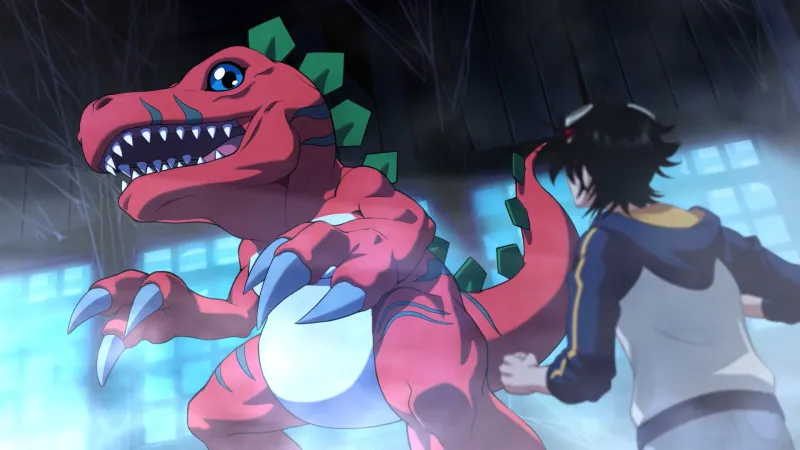After tragedy strikes our group, I try to calm down and ask that we should trust each other. Blood has been shed and tensions are at an all-time high for this lost group of teenagers trapped in a dangerous land. That’s not quite the scene I envisioned when I got into Digimon Survive, a tactical RPG in the form of a visual novel based on the sometimes kid-friendly monster franchise. The game’s dramatic dynamics are captivating, but the grid-based combat left me dozing and sour in what could have been a compelling, complete package.
As a visual novel, Digimon Survive is an absolute treat full of beautifully drawn characters and landscapes. Each location features well-crafted character staging, with camera pans and zooms giving these locations a sense of depth. I’m often put off by the sparse production values of visual novels, but Digimon Survive keeps the flow of conversation visually interesting, bolstered by a partial Japanese voice acting.
You take on the role of 14-year-old Takuma, who is surrounded by a group of other young teenagers trapped in a dangerous world after getting lost on a school field trip. Here, each child is paired with a partner Digimon through a mysterious bond that few accept. This uneasiness leads to many difficult situations that test the group’s trust in each other, their Digimon, and some characters’ grip on reality. As the story starts off slowly, I’m struck by the depth of the characters and learning about the interactions and roles everyone plays within the group.
I decided early on who was more on my side, who was worry-prone, who was headstrong and stubborn, and who was difficult or unbearable. I wouldn’t say I liked many of the characters for a while (or ever), which is great and why Survive succeeds with its characterization and relationships. Throughout my playthrough, I loved how I had to learn how to interact with each character, telling them what they wanted to hear in a certain situation, or what they needed to be told in order to level up the party and survive. The fate of these children’s lives is at stake, leading to a pleasant suspense. Even casual conversations can lead to interesting turning points for a character that can stop them from being a problem for the team or set them down a fearful path for everyone around them.
Each child is accompanied by a Digimon that appears as the group enters this new dimension. The series’ mascot, Agumon, allies with you, while others like Floramon, Lopmon, Labramon, and Falcomon become attached to the other recurring teens. These creatures play a central role in the story and are emotionally connected to human partners. I’m disappointed with some overwhelming developments for the main Digimon, but overall the interactions between you and the monsters are fun and rewarding. I enjoyed hearing about how their budding friendships progressed or not, leading to powerful moments in the story that I will remember for a long time to come.
Choices made through conversation can and will affect Digimon and their evolution, especially Agumon. As emotions drive the bond between partners, Agumon’s evolutionary tree will shift throughout the game as your conversational choices lean toward one of the three traits of Wrath, Morality, or Harmony. These options also have overarching narrative implications, creating a cool connection between story structure and turn-based combat. I appreciate that my journey can have many different effects on my monsters, but the part of the game where evolutions really matter suffers badly compared to the visual novel.
Digimon Survive’s tactical turn-based combat is too easy and lacks excitement and strategy. Each Digimon can shuffle along the map grid to position itself for attacks against enemy monsters. Digimon have a signature move and basic attack, and up to two additional equippable abilities. My favorite part about Skirmishes is the management. Using special attacks and assuming an evolved form consumes SP; Remaining in the base form for one of the main party’s monsters restores the valuable resource. The few times I’ve had to juggle evolution levels to save SP for a final attack have been stimulating and interesting. Still, that’s far from the norm when most battles are far from being mentally taxing encounters.
Rather than relying on team composition, formations, and strategically interesting attacks, most encounters play out as you simply bring your team close to the enemy and pound them with your strongest ability. Sure, there are elemental advantages, and depending on whether you’re attacking from the side or rear flank, it can result in additional destruction, but simple brute force usually gets the job done. As a result, the part of this game I was most looking forward to feels like padding and detracts from the overall experience.
Battles also allow additional Digimon to join your party, but the process is a painstaking mess. These recruitment opportunities only come from free battles while exploring, and require you to use the conversation command to start a conversation. The enemy Digimon will ask you a series of three questions, to which you will have to answer several times in the way it prefers in order to get a chance to ask it to join the team. It’s clumsy and tedious, with many interactions leading to failure. Although I wanted a cool new Digimon on my team, I finally decided it was hardly worth the effort.
I applaud Digimon Survive for being a dark, harrowing, and beautiful visual novel that subverts what I thought a Digimon story could be. While I wish the fight would unfold the same as the surrounding story presentation, it’s not enough to deter someone from watching the narrative to the end. Don’t expect a tactical masterpiece, but a well-crafted melancholic story that shows Digimon in a light they’ve never been in before.








